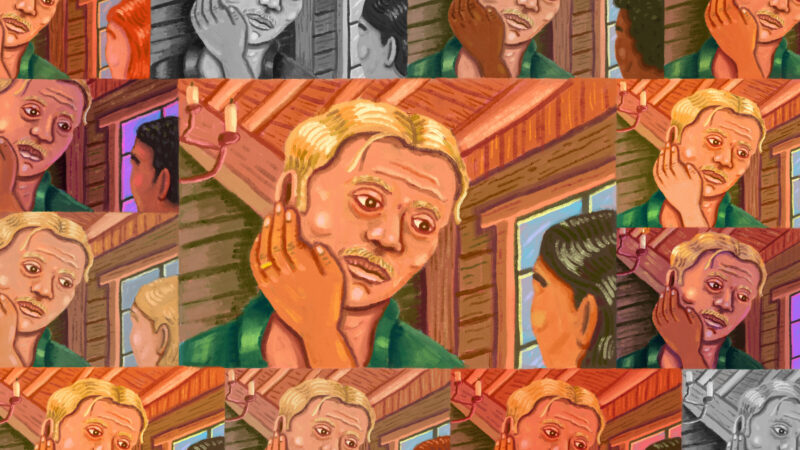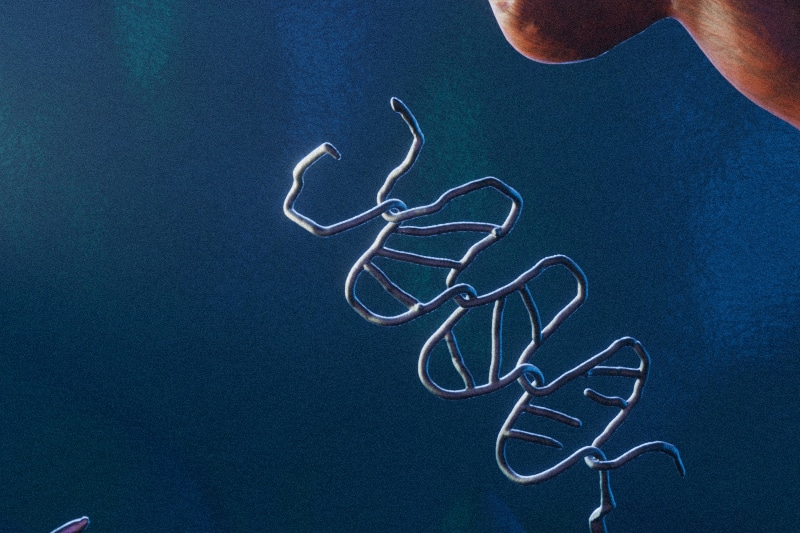In a recent episode of the podcast Women at Warp, the hosts discussed their favorite episodes of the various Star Trek series in which the Holodeck—a fully immersive, interactive virtual reality interface—is central to the plot. On occasion, a Trek character uses a Holodeck to interact with holo-versions of their crewmates, turning their coworkers and friends into unwitting characters in a storyline that they didn’t help to write. Reflecting on the potential problems of that choice, one host observed that Starfleet’s human resources department “would have a binder that was the size of Crime and Punishment for the Holodeck.”
The characters in Monica Byrne’s “Parasocial” should have read whatever is in that binder. The story takes the perspective of Jim, a divorced, isolated, and washed-out former movie star whose best job offers are now endorsement deals for naturopathic hemorrhoid cream. That is, until Molly, head of a new company named Parasocial, offers Jim more enticing and lucrative work: to be the model for Parasocial’s first “tangi”—a tangible combination of “light and force fields and AI” that will look, sound, and move exactly like Jim. People who grew up with Jim as their matinee idol can pay for sessions to interact with a version of him that is, as Jim’s lawyer friend Lee tells him, “whatever type they need you to be.” Jim proves unable to resist the temptation to see just what those “types” and “needs” are.
No matter how responsive, elaborate, or even carnal the tangis’ interactions with customers, those interactions remain stubbornly unidirectional, unreciprocated.
Jim has a decided advantage over his Star Trek counterparts, who might be totally unaware that a coworker has constructed an elaborate fantasy version of them and is interacting with it in discomfiting ways. He’s a somewhat informed and, eventually, enthusiastic participant in the monthslong construction of his tangis. But Parasocial has failed to come to grips with the privacy risks of creating tangis. The company has no plans to evaluate the psychological effects on the clients who interact with Jim’s tangis—or on Jim himself. While Molly envisions a world with an on-demand service “so anyone can sell their own tangi,” the rush to create that world means that Parasocial neglects its implications. Although Jim is the protagonist, what really propels the story forward are these failures to address important questions—questions our society needs to immediately consider.
The idea underlying Molly’s proposal to make fans’ relationships less imaginary and more visceral is a familiar one. In the 1950s, the American sociologists Donald Horton and Richard Wohl coined the term “parasocial interaction” to describe a phenomenon that they ascribed to the still relatively young mass communications technologies of radio and television. They characterized a parasocial interaction as an experience of acquaintance with a “persona” that is mediated by the airwaves or a screen, but that exists mostly or entirely in the listener’s or viewer’s head. That person experiences the physical proximity of devices—a TV set a few feet away, a phone in one’s hand, or tiny speakers in one’s ear canals—as psychological proximity to the people whose voices and images come through those technologies.
Through repeated listening and viewing, and through the performer’s repeated enactment of intimacy (hailing “you all at home,” looking directly into the camera, thanking one’s subscribers for their contributions), we in the audience come to believe that we know those performers, and maybe also that they know us and are addressing us individually. Fans then bring that sense of knowing and being known to in-person encounters.
The impulse to imagine reciprocal admiration—or even real friendship—with a celebrity, podcaster, or influencer is widespread in media-saturated cultures like ours. It’s also understandable to feel somewhat defensive about that impulse: The prefix “para”—with meanings including “defective” and “resembling”—implies either that a parasocial relationship is deficient in important ways, or that it’s not really a relationship at all. Molly’s company Parasocial attempts unsuccessfully to swat away both implications at the same time. Creating tangible avatars of Jim eliminates layers of mediation, removing one of the most obvious “deficiencies” of an interaction that occurs only through a screen. But although the story is intriguingly unclear about the nature of the tangis’ “AI” systems, the fact that those features aren’t elaborated upon suggests that the systems lack interiority. No matter how responsive, elaborate, or even carnal the tangis’ interactions with customers, those interactions remain stubbornly unidirectional, unreciprocated.
Horton and Wohl asserted that parasocial interactions exist in a state of double ambivalence. The audience both does and doesn’t mistake the person for the role that they play (the persona). And the audience both does and doesn’t mistake the persona’s ways of addressing their audience for actual knowledge of the audience; they might feel “seen” or understood by someone who cannot in fact see them and probably isn’t even aware of them as a distinct individual. We believe and disbelieve in the illusion at the same time, or move quickly between incredulity and being caught up. We catch glimpses of ambivalence throughout the story, as when one Parasocial customer’s first reaction to Jim’s tangi is disorientation: “You’re real.” We should think about how we’d resolve this ambivalence individually and societally.
Let’s return to the Starfleet HR binder. What should be in the binder for people in Jim’s and Molly’s positions—that is, someone with legions of fans eager to pay for sessions with a curated version of him- or herself, and someone else willing to provide those sessions for a fee?
They might feel “seen” or understood by someone who cannot in fact see them and probably isn’t even aware of them as a distinct individual.
Context matters, of course. Some of the technologies to make precursor tangis are already available. Women and girls, whether celebrities or not, have had to contend with deepfaked photos and videos of themselves. The 2023 strikes by SAG-AFTRA and WGA union members were driven partly by fears (or threats) that producers would alter their contracts to permit the use of AI-based systems in place of actors and writers. Thus we should expect public figures, including former movie stars, to hold a range of attitudes about their visibility and the kinds of access or authenticity they “owe” the public. Even setting aside monetary considerations, some public figures would leap at the chance to make tangis of themselves, while others would run screaming in the opposite direction.
As a matter of basic decency, it would be important for fans and others to respect that some celebrities might be completely uninterested in making tangis of themselves; others might be interested in strictly limiting the kinds of dialogue and interactions that their tangis would have. That respect should also be codified explicitly in policies and laws, similar to some already being contemplated, that might establish a right to one’s image and likeness and which could underpin restrictions on the creation of tangis.
Molly and her colleagues at Parasocial get some big things right: they seek Jim’s permission, collaborate with him, and compensate his time and labor generously (even if he considers the endeavor a form of “prostitution,” as someone who didn’t have too many other options). But the story has important lessons for our world, too. Parasocial (the company) gets two major things wrong: customer privacy and psychological care. First, how was it possible for anyone, especially Jim, to access a whole library of recorded sessions? Customers can choose whether to let Jim (and presumably others) watch their sessions with his tangi, but they can’t opt out of their sessions being recorded or used “for R&D.” This isn’t an abstract invocation of “but privacy!”—if customers like Carrie use a tangi as a kind of therapist, then Parasocial must make clear to those customers that Jim’s tangis aren’t licensed therapists (even if he played one in a movie) and that many of the longstanding norms and regulations that govern therapeutic relationships—especially those regarding counselor-patient confidentiality—aren’t in place. (Perhaps Jim’s tangis should say those things during sessions, or perhaps there should be periodic announcements from a loudspeaker.) Most customers probably know this and are there for entertainment, but the point of the reminders is to discourage customers whose original parasocial relationship was with Jim from forming a new one with Jim’s tangi, and engaging in unsafe or ill-advised behavior because of the power of that relationship. Those who find this concern speculative or hyperbolic should note that social media companies, and even a chat-based psychology helpline, have already used interactions on their sites to “train” AI systems—practices that came as unpleasant surprises to many users.
Our culture of celebrity, influence, and AI-turbocharged microtargeting provides more enticements to parasocial interactions and relationships than ever.
The second major lesson is in how Parasocial overlooks the psychological effects for Jim—who, in striking contrast to the customers, is the only character who clearly end up worse off. The story vividly illustrates Jim’s reactions to the customers’ sessions with his virtual doppelgangers. He seems ambivalent and confused about his relationships to his tangis and, through them, to his fans. Are his tangis healthy forms of self-protection from boundary-violating fans, or—as his ex-wife Amelia hints—proof of his unquenchable need for control over those fans? When Jim tricks Sam, Parasocial’s archivist, into giving him access to customers’ recorded sessions, with whom exactly is he “settling a score”? Is it Amelia, or is it those customers who believed that their sessions were private? Do people want Jim’s tangis? Do they want them for the reasons he wants them to? The company doesn’t seem to care. It pays Jim well, but it provides no one to discuss those questions. In fact, Parasocial seems interested in Jim mostly as a proof of concept on the way to a world in which we’re all selling tangis of ourselves.
“Parasocial” ends with Jim right back where he began, at the wrong end of several lawsuits and dependent once again on the kindness of a former producer. It’s unclear what lessons he has learned or was meant to have learned. Readers may feel a sense of resolution from Jim’s comeuppance, or pity at his self-destructive self-involvement, but what we should be asking is, What are the implications of living in such a world?
Most of us will never have legions of fans clamoring to purchase sessions with a version of us that could be “whatever type they needed us to be.” However, more and more of us are self-styled “influencers” of some kind or another, for whom parasociality is the coin of the realm. And at least a few people may be interested enough in the rest of us to create lookalike and soundalike digital representations of us to interact with. For all that anyone reading this essay knows, someone they know—or someone they don’t know at all—is already interacting with a rudimentary tangi of them.
Our culture of celebrity, influence, and AI-turbocharged microtargeting provides more enticements to parasocial interactions and relationships than ever. As “Parasocial” shows, consistent with research findings, some people do benefit from such interactions. But we must develop a greater appreciation and respect for the power and unpredictability of those as-if attachments, so that we can design policies and protections for ourselves—and for the fleetingly famous among us—against their potential ill effects.




